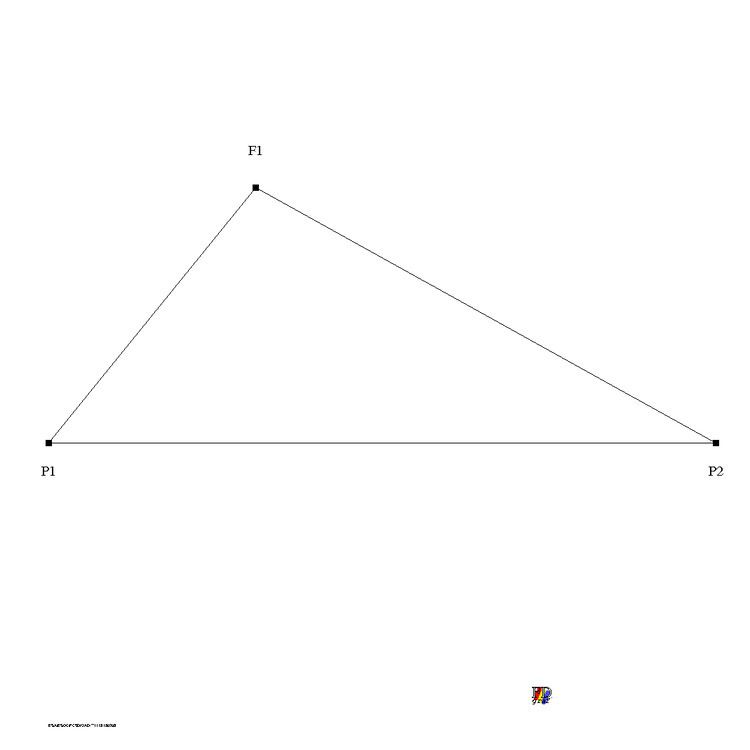 | ||
In celestial mechanics Lambert's problem is concerned with the determination of an orbit from two position vectors and the time of flight, solved by Johann Heinrich Lambert. It has important applications in the areas of rendezvous, targeting, guidance, and preliminary orbit determination. Suppose a body under the influence of a central gravitational force is observed to travel from point P1 on its conic trajectory, to a point P2 in a time T. The time of flight is related to other variables by Lambert’s theorem, which states:
Contents
- Initial geometrical analysis
- Solution of Lamberts problem assuming an elliptic transfer orbit
- Numerical example
- Practical applications
- Open source code to solve Lamberts problem
- References
Stated another way, Lambert's problem is the boundary value problem for the differential equation
of the two-body problem for which the Kepler orbit is the general solution.
The precise formulation of Lambert's problem is as follows:
Two different times
Find the solution
Initial geometrical analysis
The three points
form a triangle in the plane defined by the vectors
The points
Relative the usual canonical coordinate system defined by the major and minor axis of the hyperbola its equation is
with
For any point on the same branch of the hyperbola as
For any point
i.e.
But this means that the points
The ellipse corresponding to an arbitrary selected point
Solution of Lambert's problem assuming an elliptic transfer orbit
First one separates the cases of having the orbital pole in the direction
In case
For any
and the semi-major axis (with sign!) of the hyperbola discussed above is
The eccentricity (with sign!) for the hyperbola is
and the semi-minor axis is
The coordinates of the point
where
Using the y-coordinate of the point
The semi-major axis of the ellipse passing through the points
The distance between the foci is
and the eccentricity is consequently
The true anomaly
where
is the unit vector in the direction from
If
If
With
being known functions of the parameter y the time for the true anomaly to increase with the amount
In the special case that
Equations (11) and (12) are then replaced with
(14) is replaced by
and (15) is replaced by
Numerical example
Assume the following values for an Earth centred Kepler orbit
These are the numerical values that correspond to figures 1, 2, and 3.
Selecting the parameter y as 30000 km one gets a transfer time of 3072 seconds assuming the gravitational constant to be
This y-value corresponds to Figure 3.
With
one gets the same ellipse with the opposite direction of motion, i.e.
and a transfer time of 31645 seconds.
The radial and tangential velocity components can then be computed with the formulas (see the Kepler orbit article)
The transfer times from P1 to P2 for other values of y are displayed in Figure 4.
Practical applications
The most typical use of this algorithm to solve Lambert's problem is certainly for the design of interplanetary missions. A spacecraft traveling from the Earth to for example Mars can in first approximation be considered to follow a heliocentric elliptic Kepler orbit from the position of the Earth at the time of launch to the position of Mars at the time of arrival. By comparing the initial and the final velocity vector of this heliocentric Kepler orbit with corresponding velocity vectors for the Earth and Mars a quite good estimate of the required launch energy and of the maneuvres needed for the capture at Mars can be obtained. This approach is often used in conjunction with the patched conic approximation. This is also a method for orbit determination. If two positions of a spacecraft at different times are known with good precision from for example a GPS fix the complete orbit can be derived with this algorithm, i.e. an interpolation and an extrapolation of these two position fixes is obtained.
Open source code to solve Lambert's problem
From MATLAB central
PyKEP a Python library for space flight mechanics and astrodynamics (contains a Lambert's solver, implemented in C++ and exposed to python via boost python)
